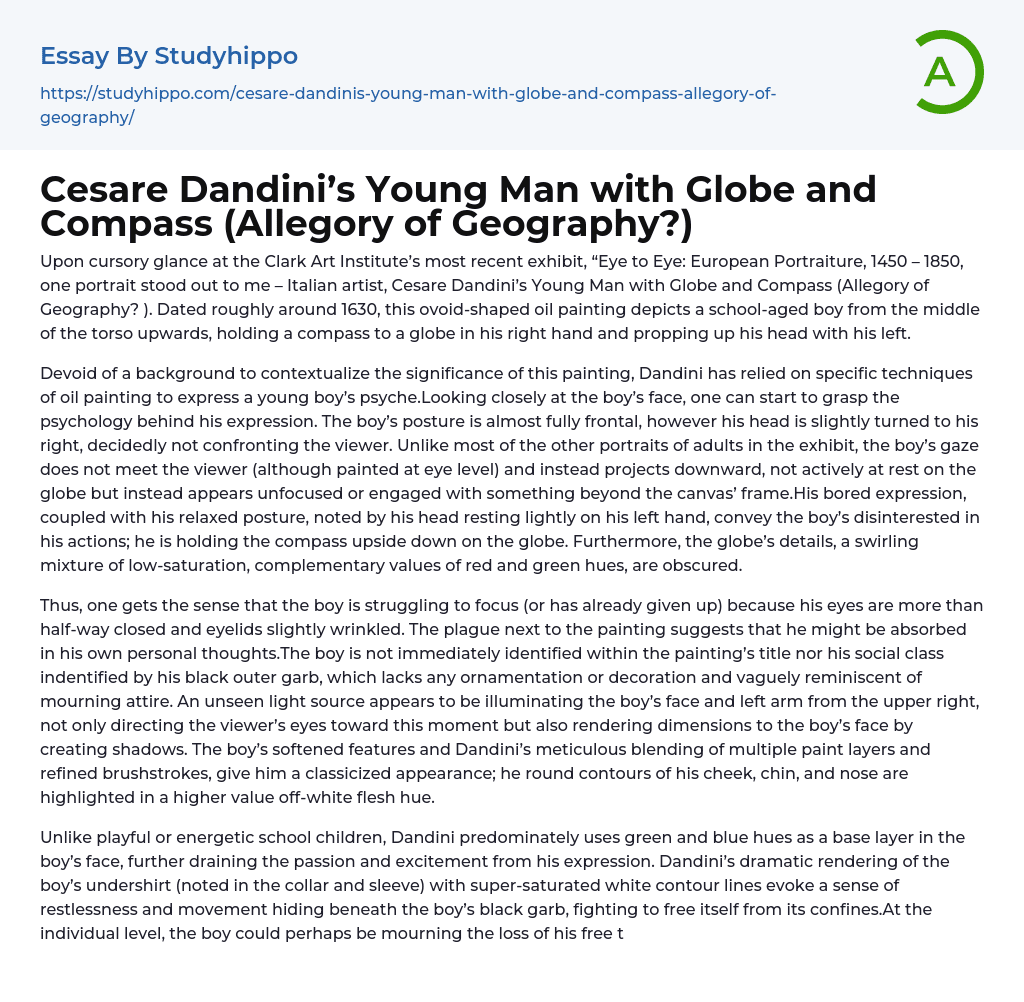

Cesare Dandini’s Young Man with Globe and Compass (Allegory of Geography?) Essay Example
Upon cursory glance at the Clark Art Institute’s most recent exhibit, “Eye to Eye: European Portraiture, 1450 – 1850, one portrait stood out to me – Italian artist, Cesare Dandini’s Young Man with Globe and Compass (Allegory of Geography? ). Dated roughly around 1630, this ovoid-shaped oil painting depicts a school-aged boy from the middle of the torso upwards, holding a compass to a globe in his right hand and propping up his head with his left.
Devoid of a background to contextualize the significance of this painting, Dandini has relied on specific techniques of oil painting to express a young boy’s psyche.Looking closely at the boy’s face, one can start to grasp the psychology behind his expression. The boy’s posture is almost fully frontal, however his head is slightly turned to his right, decidedly not confrontin
...g the viewer. Unlike most of the other portraits of adults in the exhibit, the boy’s gaze does not meet the viewer (although painted at eye level) and instead projects downward, not actively at rest on the globe but instead appears unfocused or engaged with something beyond the canvas’ frame.His bored expression, coupled with his relaxed posture, noted by his head resting lightly on his left hand, convey the boy’s disinterested in his actions; he is holding the compass upside down on the globe. Furthermore, the globe’s details, a swirling mixture of low-saturation, complementary values of red and green hues, are obscured.
Thus, one gets the sense that the boy is struggling to focus (or has already given up) because his eyes are more than half-way closed and eyelids slightly wrinkled. The plague next to the painting suggests that
he might be absorbed in his own personal thoughts.The boy is not immediately identified within the painting’s title nor his social class indentified by his black outer garb, which lacks any ornamentation or decoration and vaguely reminiscent of mourning attire. An unseen light source appears to be illuminating the boy’s face and left arm from the upper right, not only directing the viewer’s eyes toward this moment but also rendering dimensions to the boy’s face by creating shadows. The boy’s softened features and Dandini’s meticulous blending of multiple paint layers and refined brushstrokes, give him a classicized appearance; he round contours of his cheek, chin, and nose are highlighted in a higher value off-white flesh hue.
Unlike playful or energetic school children, Dandini predominately uses green and blue hues as a base layer in the boy’s face, further draining the passion and excitement from his expression. Dandini’s dramatic rendering of the boy’s undershirt (noted in the collar and sleeve) with super-saturated white contour lines evoke a sense of restlessness and movement hiding beneath the boy’s black garb, fighting to free itself from its confines.At the individual level, the boy could perhaps be mourning the loss of his free time to play due to academic study. However, in the context of the seventeen-century, especially considering European colonization and the rise of sciences, this boy (which could be anyone really) might represent on a smaller scale the organizing concept of the Baroque period – the reevaluation of humanity and its relation to the universe.
- Travel essays
- Asia essays
- Caribbean essays
- Developing Country essays
- America essays
- City essays
- Africa essays
- Australia essays
- Europe essays
- Georgia essays
- Middle East essays
- New Zealand essays
- South Korea essays
- Thailand essays
- Afghanistan essays
- Dubai essays
- North Korea essays
- Natural Disaster essays
- Earthquake essays
- Fracking essays
- Mountains essays
- Restaurant essays
- Hospitality essays
- Business Travel essays
- Hotels essays
- Tourism essays
- World Tourism Organization essays
- Kids travel essays
- Travel Agency essays
- ecotourism essays
- Air Travel essays
- Sea Travel essays
- Cathedral essays
- Traveling essays
- Fast Food Restaurant essays
- Motel essays
- Cultural Tourism essays
- The real essays
- Airlines essays
- Airports essays
- Boeing essays
- Low-Cost Carrier essays
- Easyjet essays
- Bangladesh essays
- Kuala Lumpur essays
- Malaysia essays
- Manila essays
- Philippines essays
- Singapore essays
- Vietnam essays



